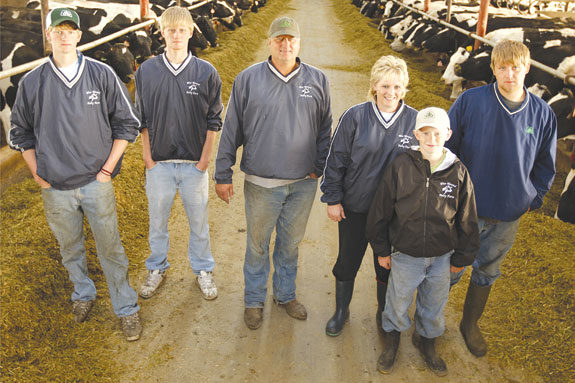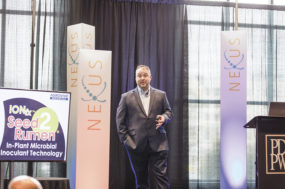Although managing dairy cows is the basic foundation of any dairy operation, the consistent management of cows and the people working with them is the principal factor to the success of Blue Mound Dairy near Luverne, Minnesota. Rick Van Santen and his wife, Carrie, own and operate the 1,000-cow dairy with the help of their four sons. Brad, the eldest of them and the dairy’s herd manager, explains that his father’s parents emigrated from Holland and started a farm in Iowa, which was relocated to its current location in Luverne in 1969. In the mid-’90s, Brad’s father purchased the farm from his grandfather and began expanding the operation.
The expansion of the farm began with the addition of a freestall barn, followed with herd size increases until reaching the current size. The dairy parlor also went from a double-six herringbone parlor to a double-eight herringbone. The double-eight setup was then replaced by the current double-16 parallel parlor to accommodate the increasing herd size.
Maintaining consistency
Expanding, however, wasn’t the only goal of the Van Santens for their dairy. They have worked continually to make improvements across all areas of the dairy, including milk production and quality.
Blue Mound Dairy has won milk quality awards from Land O’Lakes for the past six years. The dairy was also featured as virtual tour venues at the 2011 World Dairy Expo and this year’s Central Plains Dairy Expo.
“We sell our milk to Land O’Lakes and they give awards to their customers each year in categories like low somatic cell counts and low bacteria rate,” Brad says.
The dairy currently has an average bulk tank somatic cell count of 112,000. Blue Mound Dairy also reduced clinical mastitis cases to 3 percent in fresh cows and maintains a rolling herd average of 28,500 pounds.
Brad, a dairy production graduate from South Dakota State University, explains that there are several factors that have contributed to those milk quality figures. “More than anything, though, it’s just about managing the cows and making sure they’re comfortable and clean,” he says.
Brad attributes the use of sand bedding in the freestalls as one of those factors. The sand is raked three times a day and clean sand is added to the freestalls twice each week. A sand-settling lane is also used to help recover and reuse the sand.
“The sand bedding helps a lot – keeping it fresh, making sure there is enough in the stalls and making sure as much urine or manure as possible drains out,” he says.
Constantly following the right milking procedures is another factor in achieving good milk quality at Blue Mound Dairy. The dairy’s milkers are divided up into teams to cover each of the three milking shifts.
Additional employees take care of moving cows to and from the parlor, feeding all animals, scraping stalls and performing other outside work. “Each person has their set roles and knows who they are going to work with,” Brad says.
He points out that forestripping and removing the first few streams of milk before attaching the milking unit is a main point in the milking routine, as this milk usually has more bacteria. When a new person starts to work in the milking parlor, Brad explains that the person first works with the other three milkers in the parlor.
Doing this allows the new employee to watch the other employees working and carrying out the milking procedure and, in that way, learn in a hands-on format. Additionally, lead milkers in each shift are also responsible for training new milkers.
“The lead milkers know the procedure and it’s a lot easier for them to train rather than for me to demonstrate the milking routine to a worker on, maybe, one cow and then have to leave,” Brad says. “If they have a question after milking a few cows, they’ll be able to ask the lead milker.”
Another change that took place was on the feeding side of the operation. The Van Santens grow their own corn silage and alfalfa and decided to implement a high-forage diet for their cows in order to help maintain a healthier herd and, in turn, improve milk production.
“Overall though, it just comes down to management,” Brad says. “Managing cow comfort, cleanliness of stalls and keeping the same milking routine is the way to stay on top of mastitis and keep the somatic cell count low.”
Continuing to grow
In 2010, a new heifer facility was built on the dairy in order to be able to raise all replacement animals on the farm. Brad states that he and one of his brothers also purchase steers from their father. “We buy them from my dad at, like, 250 to 300 pounds and we raise them up a little ways and sell them. Also, we don’t have the facilities to keep our steers any longer,” he says.
Earlier this year, the Van Santens took on the project of installing an automatic calf-feeding system on their farm after seeing one of these systems at work on another dairy. They agreed that the system provided benefits that would help improve their calf-feeding program and, at the same time, improve their calves’ health by being able to detect earlier when calves become sick. The project was completed in early March and can accommodate 200 calves on milk and 100 weaned calves.
As with any other venture, Brad explains that there are challenges that his family’s dairy faces, in addition to maintaining the herd’s health and making sure the dairy always produces high-quality milk. One specific challenge he mentions is one that no one has control over.
“We deal with challenges like consistency of feed from year to year and adjusting rations depending on the quality of the silage, but dealing with weather change is probably the hardest thing, because weather patterns change,” he says.
Changes in weather patterns this year included a mild winter with little snowfall during the winter months. He adds that during the past few weeks, the weather changed very often. Weather changes like these can add challenges to producing quality forage for the herd or being able to determine a crop outcome.
In the future, Brad hopes to eventually purchase the dairy from his parents and continue the family’s dairy business with the help of his brothers. “I would like to see us expand into another operation or build a steer facility,” he says. “However, we already have a good facility the way it is and, as you get bigger, it will mean a lot more management.” PD
PHOTO
Every member of the Van Santen family helps on the dairy. Pictured from left to right: Austin, Derek, Rick, Carrie, Jake, Brad. Photo courtesy of Blue Mound Dairy.

Dario Martinez
Editor
Progressive Dairyman







